RODUCTION TO MOBILE NETWORKS.
TFrom circuit migration to packet migration
However, in the past decade much has changed, mainly because mobile operators have abandoned SONET / SDH circuits to adopt Ethernet, MPLS and IP in order to support new architectures. mobile link. This is a major challenge for base stations which still require very precise synchronization that native Ethernet cannot provide.
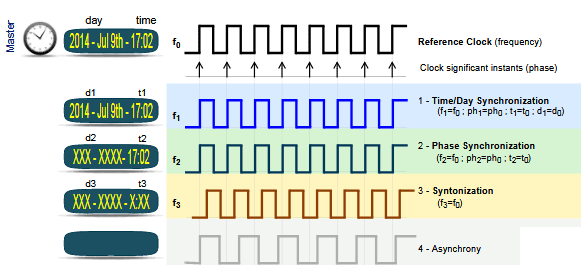
Why is mobile network synchronization necessary?
Synchronization offers many services, including assisted navigation, location and emergency calls. In addition, synchronization is fundamental for all cellular technologies, otherwise they would not even work. The base stations must continuously calculate the distance between each mobile operating in their cell and the neighboring cells. Base stations and mobiles must generate up and down frequencies exactly and must have access to transmission time bands. There are many reasons for maintaining good synchronization:
To calculate the distance to mobile devices,
To support geographic location services,
To control the transmission power,
To avoid interference with other cells and base stations,
To manage transfers,
To obtain precise access to the time slots,
To compensate for the propagation delay,
To effectively reuse frequencies,
To plan small and microcells,
To calculate billing.
We then agree that synchronization is fundamental to any basic mobile service and that it is therefore simply impossible to get rid of it.
Some notions of multiplexing and synchronization
Multiplexing and multiple access
Multiplexing is defined as the process by which multiple signals from different channels share a larger capacity channel. Basically, several channels share a common transmission medium with the aim of reducing network costs and complexity. When sharing is done with respect to a remote resource, such as a satellite, we speak of multiple access rather than multiplexing (see Figure 3). Some multiplexing technologies are:
Frequency Multiple Access (FDMA): Allocates part of the total bandwidth to each of the channels.
Time division multiple access (TDMA): Allocates all transport capacity sequentially to each channel.
Code division multiplexing (CDMA): The aerial interface facilitates multiple access on a channel using a spread spectrum with one code per transmitter
Polarization Distribution Multiple Access (PDMA): The polarization direction can be used as a multiple access technique in installations that use microwaves.
Space Distribution Multiple Access (SDMA): Using directional antennas, the same frequency can be reused, provided the antennas are properly tuned.
Duplexing
Base stations today use three technologies to multiplex upstream and downstream channels: frequency division duplexing (FDD), time division duplexing (TDD) and code division multiplexing (CDM) .
FDD base stations, The air interface uses separate frequencies for the uplink / downlink, then only requires frequency synchronization.
TDD base stations, The air interface uses the same frequency for the uplink / downlink, so an absolute time and phase reference is required to access the time slots (see Figure 4).
Tuning and Synchronization: The concepts are similar but not exactly identical.
Tuning: Alignment of clocks on the same frequency, as SDH / SONET did
Synchronization: Alignment of clocks at the same frequency and at the same phase
Time of day synchronization: Alignment of clocks on the same frequency, the same phase and a time origin. All clocks are then informed of the time and date.
ALTERNATIVES FOR A MIGRATION OF SYNCHRONIZATION OF NETWORKS
Once the mobile network has migrated to Ethernet / IP / MPLS, there are a number of alternatives for synchronization. The first is to keep the TDM signal, but it is an expensive option. The second alternative is GPS or GLONASS which can provide an absolute time reference. Finally, SyncE and PTP systems are the third solution and are based on providing synchronization through network packets. This is probably the most attractive for new mobile networks and it is a cost effective solution.
Migration of synchronization of FDD and TDD mobile networks:
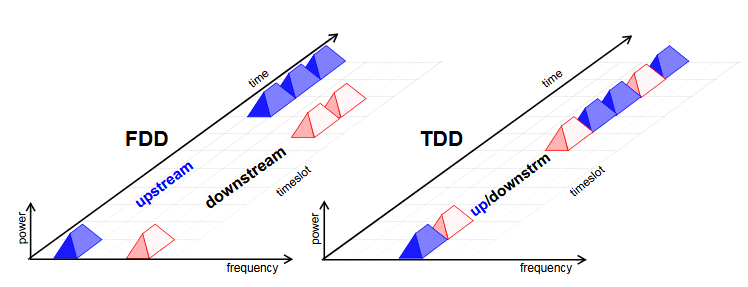
In reality many replace TDM lines with synchronous Ethernet lines and packet clocks using IEEE1588v2. SyncE and IEEE1588v2 are both add-ons to the Ethernet data network, and provide synchronization service to mobile networks. Link networks already require synchronization, and as this trend continues, synchronization is also necessary.
Tune with TDM
There are a number of TDM signals that can be used as a synchronization source:
Analog: 1.544 and 2.048 kHz
Digital: 1.544 kbit / s (T1) and 2.048 (E1) kbit / s
STM-n / OC-m line codes: from which one of the above-mentioned signals can be derived, using a dedicated circuit.
The use of STM-n / OC-m signals has the advantage of using the S1 byte to allow synchronization status messages (SSM) to indicate the performance of the clock with which the signal was generated. These messages are essential for automatically rebuilding the synchronization network in the event of a failure. They allow the clocks to choose the best possible reference and, if there is none that offers the required performance, they enter the maintenance state.
GPS or GLONASS synchronization
GPS has been available for many years (now also Russian GLONASS) and we have often heard it said "Why not integrate GPS into each base station", but unfortunately this is a vulnerable solution to interference and interference. In addition, GPS cells are smaller every day and access to antennas is not always possible, because they are deployed indoors, in data centers, in stadiums or shopping centers, where access to satellite signals is not practical or is very expensive. Even CDMA operators who have traditionally used GPS no longer see this as an acceptable solution for operational and political reasons.
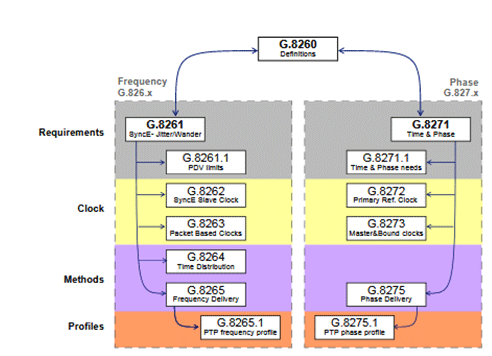
SyncE Ethernet synchronization
Synchronous Ethernet (SyncE) is an ITU-T standard that facilitates the transfer of clock signals over the physical layer of Ethernet. The signal must be able to be connected to a single external clock for the entire network. There are a number of ITU-T recommendations for this standard:
The G.8261 standard defines the architecture and the drift limit.
The G.8262 standard specifies Ethernet synchronization clocks for SyncE.
The G.8264 standard describes messaging (ESMC) for synchronous Ethernet.
On several aspects, SyncE is an evolution of SDH / SONET synchronization, because it shares many concepts, in particular synchronization architectures and topologies.
Precision time protocol (PTP)
While Sync-E can provide the synchronization required by 2G and 3G networks, PTP is suitable for networks that also require phase, frequency and time synchronization.
PTP is a two-way time transfer protocol with hardware time stamping to transport time in Ethernet frames or IP packets. Compared to SyncE, intermediate nodes do not need to be upgraded and PTP can provide not only frequency but also time and day synchronization, which is necessary for TDD mobile networks.
It is interesting to note that PTP slaves communicate with short messages to the centralized master clock via native Ethernet networks. The use of native networks has the sole requirement to transmit PTP in high priority to avoid congestion, and in particular to try to control the variation in the delay of transmission of packets.
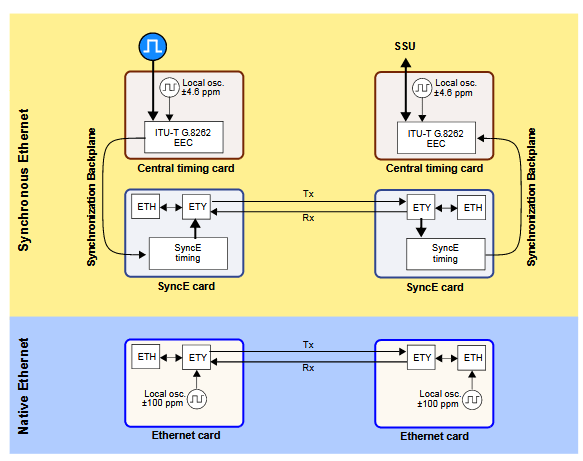
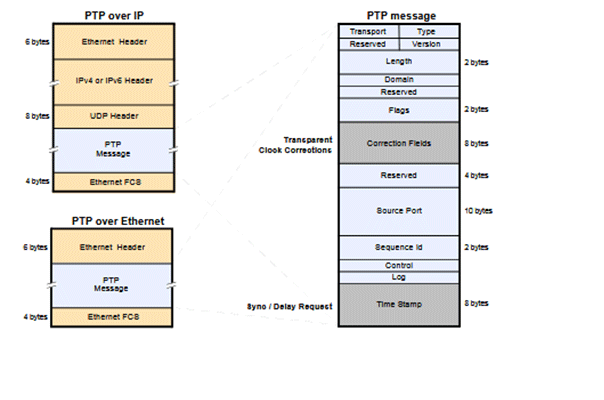
MOBILE NETWORK SYNCHRONIZATION REQUIREMENTS
Mobile operators are moving towards more efficient and higher capacity networks as there is greater demand in terms of users and data but the available radio frequencies are already largely allocated, so operators are using more in addition to new techniques to reduce the bandwidth of their existing spectrum allocations.
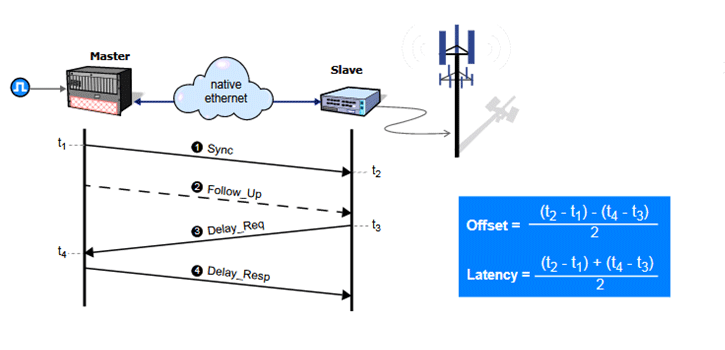
PTP profiles
The IEEE-1588 2008 standard introduced the concept of profile as a set of optional PTP features to support different types of applications. For example, a PTP profile defines control of propagation delay, required transport mechanisms, node types, message exchange rate, unicast or multicast protocol. Profiles facilitate interoperability between nodes and the deployment of PTP telecommunications networks.
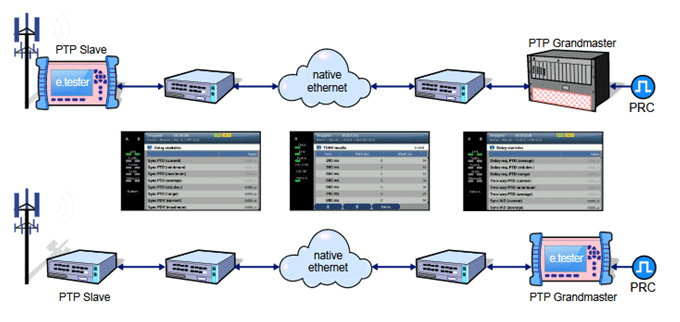
PTP INSTALLATION, COMMISSIONING AND MAINTENANCE
Commissioning
The first step is the analysis of the KPIs of the network which must transport the PTP flows in terms of capacity and quality. They can determine the success or failure of the implementation. With the Ether tester. Genius, running eSAM can simulate a PTP service including the generation of background traffic with different traffic profiles.
The main objective of eSAM is to verify that PTP frames are transported with the required performance in terms of total frame delay (FTD), variation of frame delay (FDV), frame loss ratio (FLR) ) and availability to ensure that the SLA reserved for PTP messages is preserved by the network when necessary.

